

Since the sample runtime environment allows a maximum of 256 open file descriptors per process, a “socket: too many open files” error occurs when the client establishes a connection to the server at a later stage. However, due to the context of the server’s 10s delayed reply in the above example, the client does not wait for the reply to come back by default, but tries to establish a new connection to send a new http request. We know that by default, http clients maintain connections and reuse connections to services on the same host. Let’s use a diagram to describe the situation in the above example. The value of ulimit -n in the above demo environment is 256 We see that the client above throws a panic, prompting: too many open file descriptors. Users/tonybai/Go/src//bigwhite/experiments/http-client/default-client/client.go:14 +0x78 Users/tonybai/Go/src//bigwhite/experiments/http-client/default-client/client.go:18 +0x1c7 Body)įmt.Panic: Get " dial tcp :8080: socket: too many open files Printf( "error making request: %v\n", err) Println( "Ctrl-C pressed, request cancelled.")įmt.

It often makes more sense to set a timeout that's lower than the timeout of your API.Ĭlient. a server that has a firewall blocking traffic will never complete. The http.DefaultClient timeout is infinite. This IP address is not routable, so will always timeout.

Create a cancellable context and wire it up to signals from Ctrl-C.Ĭtx, cancel := context. After the timeout elapses, the HTTP client will stop making the request and return an error. If you’re making downstream calls as part of an API that sits behind AWS API Gateway, you’ll have a maximum 30 second timeout imposed on you, so it often makes sense to set a timeout for API calls that’s lower than the timeout of your API to give your service time to respond with an error message. The Java services acccumulated more and more outbound connections until the limit of outbound network requests was reached, and the whole server was down. I’ve seen this cause problems (in Java) where a supplier changed their firewall rules and accidentally blocked traffic from an IP address my team were using to connect to their APIs. Go usually has sensible defaults, but the default HTTP client http.DefaultClient has an infinite timeout, so I’d usually advise against using that. Printf( "error creating request: %v\n", err) I think of Go channels as being a pub/sub queue like AWS SQS, except that it can also be blocking (waits for the subscriber to collect the message before proceeding) rather than non-blocking (dumps the message in the queue and carries on). Go channels are an in-memory queue of messages between goroutines. The os/signal povides the signal.Notify fuction that sends to a channel when an operating system signal is sent. Be able to cancel a request with Ctrl-C.This lets me test out the ideas in isolation before thinking about how it will work alongside everything else. When I’m planning a feature, I like to build a minimal example outside of the codebase I’m working in, before merging it back in. At the moment, there’s a short timeout to catch when servers are too slow to respond, but I want to increase the timeout and let the user decide when they’ve waited long enough for the server to respond.
GOLANG HTTP CLIENT TIMEOUT UPDATE
I wanted to update my Gemini browser to respond to Ctrl-C to cancel network requests.


 0 kommentar(er)
0 kommentar(er)
